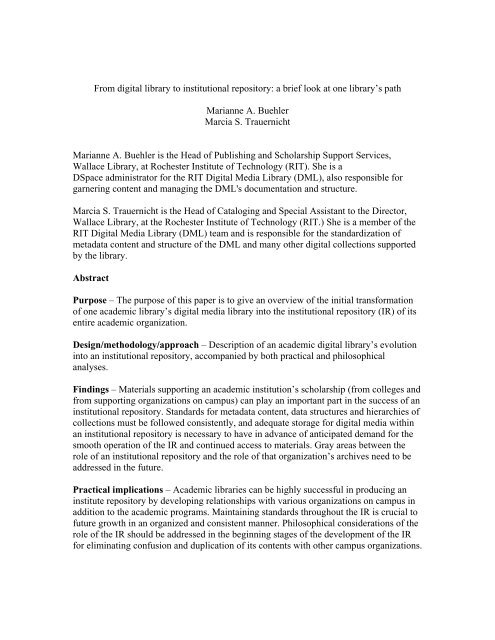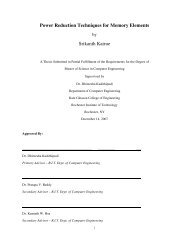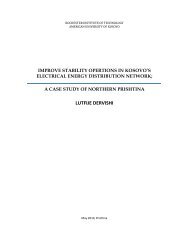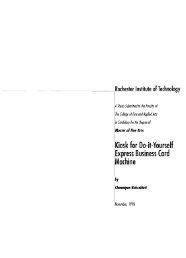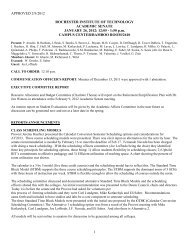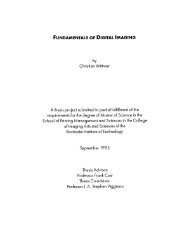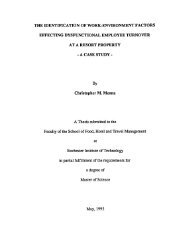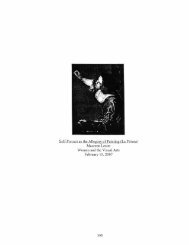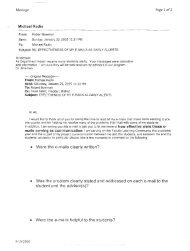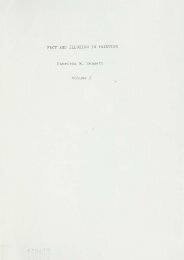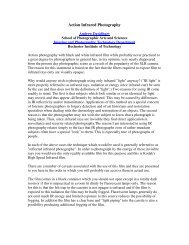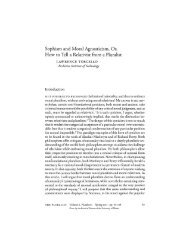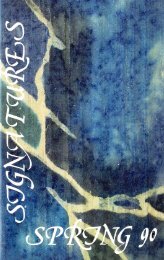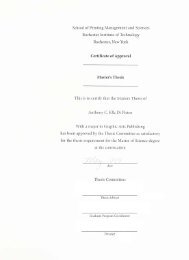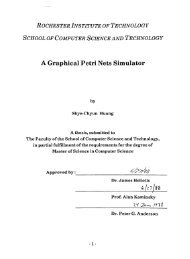From digital library to institutional repository - Rochester Institute of ...
From digital library to institutional repository - Rochester Institute of ...
From digital library to institutional repository - Rochester Institute of ...
Create successful ePaper yourself
Turn your PDF publications into a flip-book with our unique Google optimized e-Paper software.
<strong>From</strong> <strong>digital</strong> <strong>library</strong> <strong>to</strong> <strong>institutional</strong> reposi<strong>to</strong>ry: a brief look at one <strong>library</strong>’s path<br />
Marianne A. Buehler<br />
Marcia S. Trauernicht<br />
Marianne A. Buehler is the Head <strong>of</strong> Publishing and Scholarship Support Services,<br />
Wallace Library, at <strong>Rochester</strong> <strong>Institute</strong> <strong>of</strong> Technology (RIT). She is a<br />
DSpace administra<strong>to</strong>r for the RIT Digital Media Library (DML), also responsible for<br />
garnering content and managing the DML's documentation and structure.<br />
Marcia S. Trauernicht is the Head <strong>of</strong> Cataloging and Special Assistant <strong>to</strong> the Direc<strong>to</strong>r,<br />
Wallace Library, at the <strong>Rochester</strong> <strong>Institute</strong> <strong>of</strong> Technology (RIT.) She is a member <strong>of</strong> the<br />
RIT Digital Media Library (DML) team and is responsible for the standardization <strong>of</strong><br />
metadata content and structure <strong>of</strong> the DML and many other <strong>digital</strong> collections supported<br />
by the <strong>library</strong>.<br />
Abstract<br />
Purpose – The purpose <strong>of</strong> this paper is <strong>to</strong> give an overview <strong>of</strong> the initial transformation<br />
<strong>of</strong> one academic <strong>library</strong>’s <strong>digital</strong> media <strong>library</strong> in<strong>to</strong> the <strong>institutional</strong> reposi<strong>to</strong>ry (IR) <strong>of</strong> its<br />
entire academic organization.<br />
Design/methodology/approach – Description <strong>of</strong> an academic <strong>digital</strong> <strong>library</strong>’s evolution<br />
in<strong>to</strong> an <strong>institutional</strong> reposi<strong>to</strong>ry, accompanied by both practical and philosophical<br />
analyses.<br />
Findings – Materials supporting an academic institution’s scholarship (from colleges and<br />
from supporting organizations on campus) can play an important part in the success <strong>of</strong> an<br />
<strong>institutional</strong> reposi<strong>to</strong>ry. Standards for metadata content, data structures and hierarchies <strong>of</strong><br />
collections must be followed consistently, and adequate s<strong>to</strong>rage for <strong>digital</strong> media within<br />
an <strong>institutional</strong> reposi<strong>to</strong>ry is necessary <strong>to</strong> have in advance <strong>of</strong> anticipated demand for the<br />
smooth operation <strong>of</strong> the IR and continued access <strong>to</strong> materials. Gray areas between the<br />
role <strong>of</strong> an <strong>institutional</strong> reposi<strong>to</strong>ry and the role <strong>of</strong> that organization’s archives need <strong>to</strong> be<br />
addressed in the future.<br />
Practical implications – Academic libraries can be highly successful in producing an<br />
institute reposi<strong>to</strong>ry by developing relationships with various organizations on campus in<br />
addition <strong>to</strong> the academic programs. Maintaining standards throughout the IR is crucial <strong>to</strong><br />
future growth in an organized and consistent manner. Philosophical considerations <strong>of</strong> the<br />
role <strong>of</strong> the IR should be addressed in the beginning stages <strong>of</strong> the development <strong>of</strong> the IR<br />
for eliminating confusion and duplication <strong>of</strong> its contents with other campus organizations.
Originality/value – This paper describes the development <strong>of</strong> a <strong>digital</strong> <strong>library</strong>, created and<br />
maintained by an academic <strong>library</strong>, and its gradual change in<strong>to</strong> a de fac<strong>to</strong> <strong>institutional</strong><br />
reposi<strong>to</strong>ry. Other libraries in the planning stages or initial steps <strong>of</strong> creating a campuswide<br />
<strong>digital</strong> <strong>library</strong> or an <strong>institutional</strong> reposi<strong>to</strong>ry can benefit from the description <strong>of</strong><br />
possible successes and problems that they could encounter during implementation.<br />
Keywords Institutional reposi<strong>to</strong>ries, Digital libraries, Archives<br />
Paper type Case study<br />
Garnering content for an <strong>institutional</strong> reposi<strong>to</strong>ry (IR) encompasses many detailed aspects<br />
ranging from engaging university producers <strong>of</strong> scholarly content through the submission<br />
process. Each institution has <strong>to</strong> make its own philosophical decisions <strong>of</strong> what items and<br />
types <strong>of</strong> materials are <strong>to</strong> be included in an IR, which then precipitates the need for other<br />
determinations that will fulfill the mission <strong>of</strong> an IR. In addition <strong>to</strong> faculty e-prints and<br />
student electronic theses and dissertations (ETDs), the <strong>Rochester</strong> <strong>Institute</strong> <strong>of</strong> Technology<br />
(RIT) Libraries have encouraged tangential scholarly IR items such as open access<br />
journals (RIT), academic newsletters, campus-wide publications, and other academic or<br />
administrative documents <strong>to</strong> be included. Each community, such as a college or a campus<br />
division, is encouraged <strong>to</strong> determine what item-types it wants <strong>to</strong> include in its space. This<br />
does not detract from the scholarly nature <strong>of</strong> the reposi<strong>to</strong>ry for the academic side.<br />
Another question <strong>to</strong> contemplate is whether or not his<strong>to</strong>rical documents that already exist<br />
in the RIT Archive should be also made available online in the IR. Standardizations <strong>of</strong><br />
hierarchies, metadata, and taking in<strong>to</strong> consideration the unique needs <strong>of</strong> each community<br />
are important advisements <strong>to</strong> garner a critical mass <strong>of</strong> materials’ support from college and<br />
non-college divisions.
Institutional reposi<strong>to</strong>ries are important for the managing and dissemination <strong>of</strong> a<br />
university’s intellectual property as part <strong>of</strong> its information assets strategy. Digital<br />
reposi<strong>to</strong>ries typically preserve and showcase an institution’s research (faculty and<br />
student), presentations, images, teaching materials, and administrative documents. These<br />
items are searchable and retrievable, deriving maximum benefit from the reposi<strong>to</strong>ry. The<br />
open access standard enhances these opportunities for the use <strong>of</strong> archived research,<br />
increases a global likelihood <strong>of</strong> collaborations among different disciplines, and provides<br />
for potential learning experiences (Hayes, 2005). The RIT Libraries define their open<br />
access <strong>institutional</strong> reposi<strong>to</strong>ry in a broad sense as an archive that houses peer-reviewed<br />
intellectual work, related <strong>to</strong> research and teaching that also includes materials<br />
representing RIT’s cultural, his<strong>to</strong>rical, and administrative documentation. The level <strong>of</strong><br />
peer-review is based on a continuum starting at a basic level <strong>of</strong> faculty-<strong>to</strong>-faculty or<br />
faculty-<strong>to</strong>-student <strong>to</strong> that <strong>of</strong> the classic journal edi<strong>to</strong>r review.<br />
Given the positive attributes <strong>of</strong> a university IR, the RIT Libraries (made up <strong>of</strong> Wallace<br />
Library, the Melbert B. Cary, Jr. Graphic Arts Collection and the RIT Archive) embarked<br />
upon creating and establishing an IR (the RIT Digital Media Library (RIT DML)) in late<br />
2002. Over 40% <strong>of</strong> the <strong>library</strong> staff was involved in collaborative teamwork that resulted<br />
in initially surveying RIT faculty and staff for their interest and archiving needs, then<br />
researching IR platforms (DSpace was selected) and various item formats, creating a<br />
cus<strong>to</strong>m “look,” and garnering buy-in from RIT constituencies (see Figure 1).
Take in Figure (No.1)<br />
Figure 1.<br />
Cus<strong>to</strong>mized DSpace s<strong>of</strong>tware for a personalized and colorful “look”<br />
One <strong>of</strong> the best advantages for the Libraries’ creation <strong>of</strong> an IR at that point in time was<br />
that the RIT administration was simultaneously developing its strategic plan that included<br />
increasing RIT faculty scholarship and increasing research among faculty and with<br />
students. Dissemination <strong>of</strong> the scholarship was also an imperative (Buehler, 2005).<br />
Reflecting upon the previous four years’ evolution <strong>of</strong> the RIT DML’s HYPERLINK<br />
"http://ritdml.rit.edu" conception, the RIT Libraries’ IR philosophical views, processes<br />
and activities have evolved <strong>to</strong> include additional types <strong>of</strong> materials, which in turn, have<br />
forged new and positive relationships with RIT’s academic departments, the university’s<br />
eight colleges, and the Libraries. Many faculty members have research, articles,
conference proceedings, monographs, and reports with citations only listed on their<br />
department or personal web pages. Few have full-text available. The upkeep <strong>of</strong> websites<br />
can be a time and priority challenge. The RIT Libraries’ <strong>of</strong>fer <strong>to</strong> post and maintain the<br />
full text <strong>of</strong> scholarly, peer-reviewed materials will continue <strong>to</strong> prove a worthwhile<br />
opportunity <strong>to</strong> many <strong>of</strong> the faculty. In this article, the RIT DML and RIT’s IR are referred<br />
<strong>to</strong> as one in the same.<br />
After the creation <strong>of</strong> the RIT DML site that mirrors the structure <strong>of</strong> RIT (each <strong>of</strong> the eight<br />
colleges have their own community, as does academic support departments, such as the<br />
RIT Libraries, Academic Affairs, Student Affairs, Office <strong>of</strong> the President, RIT<br />
Governance, University News, and others), the next step was <strong>to</strong> commence creating<br />
hierarchies that would reflect how each college or division was set up. A hierarchy was<br />
based overall (in seven <strong>of</strong> the colleges) on the particular college and its departments,<br />
breaking the departmental sub-communities in<strong>to</strong> faculty scholarship, student scholarship,<br />
and administrative document collections. By following the departmental hierarchy <strong>of</strong><br />
each college and the format <strong>of</strong> separating scholarship by category <strong>of</strong> author (faculty,<br />
student and administration) within the collections, the <strong>library</strong> staff endeavored <strong>to</strong> create a<br />
community and collection structure that could be retained as new programs <strong>of</strong> study are<br />
added in the future, and as current programs change or merge with other programs within<br />
the college (see Figure 2).<br />
Take in Figure (No. 2)
Figure 2.<br />
Delineating types <strong>of</strong> materials within each sub-community for consistent access<br />
This approach makes it much simpler for the <strong>library</strong> staff <strong>to</strong> update each college<br />
community without the need <strong>to</strong> make multiple changes throughout the IR, saving staff<br />
time, and the standardized structure provides consistency and reliability <strong>of</strong> access for<br />
those searching within the IR. The eighth college preferred <strong>to</strong> group its scholarship in<strong>to</strong><br />
disciplines or areas <strong>of</strong> research, with sub-<strong>to</strong>pics under each. The reasoning given behind<br />
this departure <strong>of</strong> the RIT IR’s college community structure or hierarchy was <strong>to</strong> emphasize<br />
scholarship that cut across departments and units <strong>of</strong> that college rather than separate<br />
faculty and staff scholarship on the same <strong>to</strong>pic by a purely administrative structure. Since<br />
so many faculty and staff members <strong>of</strong> that college collaborate across departments on a<br />
regular basis, it was felt that those searching for its scholarship by entering its reposi<strong>to</strong>ry<br />
community would not be able <strong>to</strong> locate the materials in a specific area <strong>of</strong> research
through a departmental hierarchy. After much deliberation on this request, the <strong>library</strong><br />
staff set up the eighth college’s hierarchy as requested. A year after this structure was<br />
implemented, requests <strong>to</strong> change the subject hierarchy <strong>to</strong> that <strong>of</strong><br />
departmental/administrative, identical <strong>to</strong> the other colleges, came pouring in from both<br />
the college and <strong>library</strong> staff. The common complaint made was that no one could find<br />
anything. This episode reinforced the need <strong>to</strong> retain standardization <strong>of</strong> hierarchies within<br />
the IR for the same types <strong>of</strong> communities, and that the <strong>library</strong> staff should not depart<br />
from its role as the administra<strong>to</strong>r <strong>of</strong> the IR in maintaining that standardization.<br />
As has been noted in many publications, at conferences, and within collegial<br />
conversations, it is common knowledge that garnering faculty and research content is a<br />
challenge. At RIT, the colleges span subject/research areas that range from the sciences<br />
(chemistry, physics, etc.), engineering/engineering technology, business, computer<br />
science and information technology <strong>to</strong> liberal arts, hospitality/<strong>to</strong>urism, printing, ceramics,<br />
pho<strong>to</strong>graphy, and furniture design <strong>to</strong> Deaf culture and American Sign Language. Given<br />
the wide variety <strong>of</strong> types <strong>of</strong> scholarship that are engendered, the variables rise on why<br />
some faculty members are willing <strong>to</strong> have their work posted and others are not. Some <strong>of</strong><br />
the more notable and universally experienced basis RIT faculty give as reasons <strong>of</strong><br />
resistance <strong>to</strong> using an IR are: the time and priority fac<strong>to</strong>r, a lack <strong>of</strong> awareness <strong>of</strong> or<br />
unconvinced <strong>of</strong> the immediate value, copyright retention concerns, and the potential<br />
impediment or undermining <strong>of</strong> the traditional scholarly publishing system that faculty
ely on for tenure and pr<strong>of</strong>essional recognition, as faculty members also prefer <strong>to</strong> exert<br />
full control over their scholarly content (Cervone, 2004).<br />
To alleviate as many <strong>of</strong> the faculty IR buy-in concerns as possible, the Publishing and<br />
Scholarship Support Services department, as one <strong>of</strong> its main missions that focuses on<br />
supporting scholarly activities (that includes <strong>of</strong>fering dissemination venues) is <strong>to</strong> manage<br />
various aspects <strong>of</strong> the IR, including assisting faculty submit their scholarship in the IR.<br />
Students who work in the actual physical space <strong>of</strong> the Publishing and Scholarship<br />
Support Center (PSSC) HYPERLINK "http://wally.rit.edu/userservices/pubschol/" post<br />
the vast majority <strong>of</strong> RIT materials in the reposi<strong>to</strong>ry (see Figure 3).<br />
Take in Figure (No.3)<br />
Figure 3.<br />
The Publishing and Scholarship Support Center
The College <strong>of</strong> Science (COS) Dean has given permission <strong>to</strong> harvest and post all COS<br />
faculty scholarship. Since the faculty members have already posted or published their<br />
materials in other venues, PSSC staff members are harvesting faculty work wherever<br />
feasible, taking in<strong>to</strong> consideration copyright ownership. PSSC student employees harvest<br />
metadata and documents in Cornell University’s open access arXiv that maintains e-<br />
prints in physics, mathematics, computer science and quantitative biology, and then post<br />
the COS faculty pre-prints, postprints and reports in the IR. If the documents have been<br />
also published in a journal, that information is included in the metadata.<br />
In instances where RIT faculty members have published in journals that require the<br />
author’s post-print (which seems <strong>to</strong> be most common), the PSSC staff requests the article<br />
from the faculty. Unfortunately, many authors do not retain their final copy, especially<br />
for retrospective materials. When the final e-print is not available, the PSSC posts the<br />
metadata only. When the journal necessitates its final post-print in an IR (less common),<br />
that copy is posted and additional, required publication documentation, such as journal<br />
copyright information and or a link <strong>to</strong> the online journal is included. An option for e-<br />
prints in an instance where the author does not own the copyright, is <strong>to</strong> input the metadata<br />
and include a PDF <strong>of</strong> the journal’s policy that precludes open access in an IR, so that<br />
users are aware <strong>of</strong> why the full-text is absent. PSSC student employees are trained <strong>to</strong> use<br />
the University <strong>of</strong> Nottingham’s SHERPA RoMEO website HYPERLINK<br />
"http://www.sherpa.ac.uk/romeo.php" <strong>to</strong> assist in determining journal/publisher
qualifications for publisher copyright self-archiving policies. They then PDF a particular<br />
journal policy web page and post it in place <strong>of</strong> the full-text document (see Figure 4).<br />
Take in Figure (No. 4)<br />
Figure 4.<br />
This document replaces the full-text when journal copyright precludes IR posting.<br />
In other cases, faculty article metadata is input with a direct link <strong>to</strong> an article, such as<br />
what is required from the American Chemical Society’s website publications.<br />
HYPERLINK "http://acswebcontent.acs.org/home.html" The Libraries as publisher<br />
assure basic standards by ensuring copyright compliance and by including sufficient<br />
metadata and the full-text where possible, in order <strong>to</strong> provide optimum use.
Over the past few years, the academic community has observed publishers, such as<br />
Elsevier, who have changed their open access policy <strong>to</strong> allow authors <strong>to</strong> post their<br />
personal scholarship on an <strong>institutional</strong> server. Given the evolving nature <strong>of</strong> open access<br />
and publishers’ policies, the philosophy <strong>of</strong> the Head <strong>of</strong> the PSSC is <strong>to</strong> post the metadata<br />
and the Sherpa documentation (as the uploaded file for an item). As each publisher<br />
recognizes the open access movement for the greater good <strong>of</strong> globally sharing scholarly<br />
work by permitting posting in an IR, the Sherpa document can be replaced with an<br />
author’s final work.<br />
The PSSC also accepts electronic or paper materials from faculty. In addition <strong>to</strong> preprint<br />
and post-print articles, monographs, book chapters, reports, poetry, workbooks,<br />
conference proceedings (including PowerPoint presentations), symposiums, websites,<br />
faculty-generated newsletters, bibliographies, RIT faculty theses and dissertations, and<br />
faculty-recommended exemplary undergraduate works are posted.<br />
The RIT Libraries recently worked with the College <strong>of</strong> Applied Science and Technology<br />
in launching the Libraries’ first open access publication, The Journal <strong>of</strong> Applied Science<br />
and Engineering Technology (JASET). In using the Open Journal S<strong>of</strong>tware (OJS), for<br />
journal-creation, one <strong>of</strong> the requirements is <strong>to</strong> post all articles in the university’s IR. In<br />
spring 2007, the first issue <strong>of</strong> JASET will be posted in RIT’s IR (see Figure 5).<br />
Take in Figure (No.5)
Figure 5.<br />
JASET will be posted in the RIT DML in spring 2007<br />
Student theses, dissertations, and caps<strong>to</strong>ne projects (or Electronic Theses and<br />
Dissertations (ETDs)) are far less complicated <strong>to</strong> post, as a student owns his or her<br />
paper’s copyright and tends <strong>to</strong> see an immediate value for using the IR as a current or<br />
future career <strong>to</strong>ol. The PSSC staff posts the ETDs in<strong>to</strong> the RIT DML as an expansion <strong>of</strong><br />
its service <strong>of</strong> binding theses and dissertations for RIT students. At this time, manda<strong>to</strong>ry<br />
electronic submission is not a requirement for the completion <strong>of</strong> a master’s or doc<strong>to</strong>rate<br />
degree at RIT, and is purely voluntary. (A print copy is accepted as the document <strong>of</strong><br />
record at this time, and retained in the RIT Archive.) RIT graduates, in growing numbers,<br />
have been very eager <strong>to</strong> have their scholarship posted at a permanent and freely-<br />
accessible site so that the URIs (uniform resource identifiers) <strong>of</strong> those works can be given<br />
<strong>to</strong> potential employers as part <strong>of</strong> the graduates’ portfolios <strong>of</strong> work. <strong>From</strong> September 2005
<strong>to</strong> September 2006, 58% (160) <strong>of</strong> the 275 bound theses and dissertations received within<br />
that time period were submitted <strong>to</strong> the IR. Electronic access <strong>to</strong> these works provides<br />
immediate and potentially world-wide recognition for the authors, and savvy students<br />
have taken advantage <strong>of</strong> the opportunities provided <strong>to</strong> them by the DML. Currently,<br />
<strong>digital</strong> images that may accompany an ETD are available in the RIT DML, but the s<strong>to</strong>ring<br />
<strong>of</strong> and access <strong>to</strong> audio, video and multimedia files have yet <strong>to</strong> be refined and substantially<br />
supported (see Figure 6)<br />
Take in Figure (No.6)<br />
Figure 6.<br />
Accompanying <strong>digital</strong> pho<strong>to</strong>s <strong>to</strong> a 1978 RIT thesis<br />
Executable files, primarily in the area <strong>of</strong> Computer Science, also accompany a number <strong>of</strong><br />
works. The problems <strong>of</strong> supporting such files plus security issues continue <strong>to</strong> be studied.
Coordination <strong>of</strong> the RIT DML, the processing <strong>of</strong> ETDs and submission <strong>of</strong> those works <strong>to</strong><br />
the UMI/ProQuest dissertation services are now being addressed by the <strong>library</strong> staff.<br />
While the PSSC has posted many faculty documents and graduate student work in the<br />
RIT DML, there are other divisions on campus that have scholarly-related materials that<br />
either report on scholarly activities, support aspects <strong>of</strong> scholarly work within its content,<br />
or are creative works in themselves. Because <strong>of</strong> the scholarly nature <strong>of</strong> the content <strong>of</strong><br />
these publications, it was decided <strong>to</strong> include these peripheral and integral items whether<br />
they are born <strong>digital</strong> or in print. In some cases, <strong>digital</strong> files are received and in others, the<br />
actual print documents are scanned. The non-college divisions have been surprisingly<br />
supportive and interested in participating, with one staff member stating, “We want <strong>to</strong> be<br />
part <strong>of</strong> the RIT DML family.” The student magazine, The Reporter, has issues dating<br />
back <strong>to</strong> 1951. <strong>From</strong> 1951-1963, the publication was in a large 12”x17” format. The<br />
Publishing and Scholarship Support Services department purchased a large-bed model<br />
scanner <strong>to</strong> accommodate the 3500+ issues that will be posted in the IR. The Reporter’s<br />
edi<strong>to</strong>rs have been concerned about the lack <strong>of</strong> a sustainable archival system for their<br />
publication. They are pleased that RIT’s IR will maintain the magazine in perpetuity and<br />
will also serve the needs <strong>of</strong> the many people who contact them in order <strong>to</strong> locate<br />
previously published articles (see Figure 7).<br />
Take in Figure (No.7)
Figure 7.<br />
A 1951 digitized copy <strong>of</strong> the Reporter student magazine<br />
The University News community was the first <strong>to</strong> request having its biweekly newsletter<br />
(RIT news&events) posted in the DML. News items typically published focus on faculty<br />
scholarship that includes publications, upcoming or prior presentations, lectures/poetry<br />
readings, viewpoints, reports on current research, academic contests/awards, and other<br />
newsmaker information. To date, the Publishing Center’s assistant has input files from<br />
Oc<strong>to</strong>ber 2002-December 2004. Keywords are alphabetized for easy review for those<br />
preferring <strong>to</strong> browse a citation.<br />
Other publications that are IR-worthy and have been incorporated in the DML are the
Academic Support Center Quarterly that focuses on <strong>to</strong>pics such as teaching and learning,<br />
academic assessment, learning disabilities, and student success. Signatures, RIT's journal<br />
<strong>of</strong> art and literature, encompasses creative poetry, images, pho<strong>to</strong>graphy, and more by<br />
students. In recent years, Signatures’ web version has a multimedia component that the<br />
PSSC hopes <strong>to</strong> capture in the DML. The PSSC students also post the University<br />
Magazine, the <strong>of</strong>ficial publication for RIT alumni, issued fall, winter and spring. It<br />
promotes an alumni connection with its current academic research, cultural activities,<br />
ongoing alumni services, and on individual alumni successes. The Scholarship@RIT<br />
newsletter, a PSSC publication that highlights the Libraries’ Faculty Scholar Series’<br />
presentations, research, teaching projects, faculty sabbaticals, showcases student work,<br />
and provides copyright and licensing articles, is also posted in the reposi<strong>to</strong>ry (see Figure<br />
8).<br />
Take in Figure (No.8)
Figure 8.<br />
The Scholarship@RIT newsletter is available in RIT’s <strong>institutional</strong> reposi<strong>to</strong>ry<br />
Test Targets magazine and The Scholarship Report are valuable faculty-created<br />
contributions <strong>to</strong> the IR. The most recent addition <strong>to</strong> the DML is the ITS (Information<br />
Technology Services) News, that details current IT projects at RIT and how <strong>to</strong> use<br />
various products and services supported by ITS.<br />
Aside from the easy availability <strong>of</strong> RIT-created documents in the IR, one <strong>of</strong> the most<br />
useful aspects <strong>of</strong> providing open access <strong>to</strong> the publications is the built-in DSpace PDF<br />
search <strong>to</strong>ol that allows text that has been PDFed with optical character recognition (OCR)<br />
s<strong>of</strong>tware <strong>to</strong> search for keywords in all items. It makes for an effective search that returns
all <strong>of</strong> the items that have the requested key words. Using the search function in a PDF<br />
document (binoculars icon), one can then search an individual item using the keywords,<br />
finding each instance <strong>of</strong> its use.<br />
Having an efficient search engine <strong>to</strong> use when searching within archived administrative<br />
documents is an advantage when trying <strong>to</strong> locating <strong>to</strong>pics that are potentially spread out<br />
among many collections <strong>of</strong> documents. RIT’s Academic Senate (AS) worked with the<br />
Publishing and Scholarship Support Services <strong>to</strong> determine a hierarchical system that<br />
would serve <strong>to</strong> provide a transparency <strong>of</strong> seeking AS documentation <strong>to</strong> the RIT<br />
community, avoiding the pitfalls <strong>of</strong> a non-searchable website interface. The AS secretary<br />
now emails links <strong>to</strong> the RIT staff that point <strong>to</strong> the document citation in the IR instead <strong>of</strong><br />
sending attached documents that take up valuable space in individual email accounts.<br />
There is potential for RIT’s 900 faculty members <strong>to</strong> access the IR on a regular basis <strong>to</strong><br />
read the AS documents and become interested in the IR’s concept for their own purposes.<br />
For AS working documents that are restricted <strong>to</strong> AS Sena<strong>to</strong>rs-only, the <strong>to</strong>p level IR<br />
administra<strong>to</strong>r set up an LDAP-authenticated collection for their use. Other RIT<br />
governance bodies are currently exploring the possibilities <strong>of</strong> also posting administrative<br />
materials in the DML, as are some college divisions. The plan is <strong>to</strong> also “lock down”<br />
these other collections for RIT use only. The citations are viewable. When a user clicks<br />
on the View/Open link <strong>to</strong> read the document, a screen pops up asking for the person <strong>to</strong><br />
login (see Figure 9).
Take in Figure (No. 9)<br />
Figure 9.<br />
The RIT DML authentication screen asking users <strong>to</strong> login<br />
As the RIT DML has grown and developed over the past four years in<strong>to</strong> an <strong>institutional</strong><br />
reposi<strong>to</strong>ry, an overlapping <strong>of</strong> its scope with that <strong>of</strong> the RIT Archive has become very<br />
apparent. As stated earlier, the RIT DML has begun acquiring peripheral materials that<br />
support RIT scholarship. Most <strong>of</strong> these materials are also his<strong>to</strong>rical in nature, and many<br />
are housed in the RIT Archive in their original print versions. And, all <strong>of</strong> RIT’s master’s<br />
theses and Ph.D. dissertations are also maintained there, again in hard copy.<br />
Concern on both the RIT DML staff’s and the RIT Archivist’s parts has brought about<br />
many ongoing discussions on what types <strong>of</strong> his<strong>to</strong>rical institute materials should be
present in the IR or are more appropriately supported by a separate Archives records<br />
management system or via the Archive’s own website. Briefly, a records management<br />
system provides “systematic and administration control <strong>of</strong> records throughout their life-<br />
cycle <strong>to</strong> ensure efficiency and economy in their creation, use, handling, control,<br />
maintenance, and disposition.” (Pearce-Moses 2005) Selected materials or records are<br />
archived because <strong>of</strong> their his<strong>to</strong>rical value <strong>to</strong> an organization. Both the RIT Archive and<br />
the RIT DML agree on providing permanent access <strong>to</strong> RIT-related materials, but concern<br />
over duplication <strong>of</strong> effort and appropriateness <strong>of</strong> some materials (though not because <strong>of</strong><br />
sensitive information) being present within the RIT DML versus the appeal <strong>of</strong> easy<br />
accessibility and a highly visible presence <strong>of</strong> archival materials via the RIT DML has not<br />
been resolved on the RIT Libraries’ part. At this time, neither the RIT Archive nor RIT<br />
itself has a fully developed records management system, so all have concurred <strong>to</strong> post<br />
some materials as the best approach for both the RIT DML and the RIT Archive at this<br />
time. As an RIT Archive records management system evolves, this discussion will<br />
resume.<br />
The inclusion <strong>of</strong> all IR items require workable hierarchies and appropriate metadata<br />
schema. Within the RIT DML, the area <strong>of</strong> metadata continues <strong>to</strong> evolve and expand, as<br />
more varied types <strong>of</strong> materials are added <strong>to</strong> the IR. For each new format <strong>of</strong> material<br />
added <strong>to</strong> the RIT DML, the Head <strong>of</strong> Cataloging establishes additional enhanced Dublin<br />
Core fields appropriate <strong>to</strong> that material, and those fields are added <strong>to</strong> the metadata
template for that format by the Library’s programmer. For eprints and ETDs, the author’s<br />
keywords are utilized whenever they are supplied. ETDs also receive Library <strong>of</strong> Congress<br />
subject headings, since it is a current RIT requirement that all graduate theses and<br />
dissertations be fully cataloged in the online public access catalog (OPAC) (see Figure<br />
10)<br />
Take in Figure (No.10).<br />
Figure 10.<br />
OPAC view <strong>of</strong> ETD that has been cataloged<br />
RIT’s Head <strong>of</strong> Cataloging establishes metadata guidelines for each new type <strong>of</strong> material<br />
<strong>to</strong> be added <strong>to</strong> the IR, and <strong>of</strong>ten creates one or two pro<strong>to</strong>type records as templates for the<br />
PSSC staff members <strong>to</strong> emulate as they post recurrent items such as newsletter issues,<br />
etc. PSSC staff <strong>of</strong>ten supplies additional keywords for these materials <strong>to</strong> enhance
keyword access, even though each individual issue can be searched full-text. A future<br />
goal is <strong>to</strong> utilize discipline-specific established thesauri terms for the scholarly work in<br />
various disciplines in addition <strong>to</strong> maintaining keyword access, although the demand from<br />
the colleges has been very light at most for this type <strong>of</strong> enhancement.<br />
Server space set aside for the RIT DML has been outgrown since the IR’s inception.<br />
Within the past year, items had <strong>to</strong> be held for a time as the Library acquired additional<br />
server space. Text-only items, images and just one or two small video clips have been<br />
accepted, since the RIT DML could not accommodate large video or audio files in an<br />
adequate manner. Currently work is being done on a project that will allow access from<br />
the DML <strong>to</strong> large video files housed on a separate server. In order <strong>to</strong> serve the immediate<br />
needs <strong>of</strong> the campus community, this approach may be utilized on a larger scale.<br />
However, the long-term security <strong>of</strong> archiving institute reposi<strong>to</strong>ry files in a separate<br />
location that is not formally associated with the IR must be addressed.<br />
By archiving and preserving faculty, staff, and student peer-reviewed scholarly materials,<br />
the RIT Libraries are providing value for the creative output <strong>of</strong> RIT scholarship on a<br />
personal, departmental, college, and university level. The goal is <strong>to</strong> create a<br />
comprehensive, well designed archive with useful metadata <strong>to</strong> showcase RIT’s<br />
intellectual, his<strong>to</strong>rical, and cultural materials, in a variety <strong>of</strong> formats. By garnering<br />
content from all areas <strong>of</strong> the campus <strong>to</strong> highlight the university’s creative output in ways
that encourage collaboration, exposure, and value within RIT and on a national and<br />
global level, the RIT Libraries will have achieved their goal <strong>of</strong> an <strong>institutional</strong> reposi<strong>to</strong>ry.<br />
References<br />
Buehler, M.A. & Boateng, A. 2005, "The evolving impact <strong>of</strong> <strong>institutional</strong> reposi<strong>to</strong>ries on<br />
reference librarians," Reference Services Review, vol. 33, no. 3, pp. 291.<br />
Cervone, H.F. June 1, 2004, "The Reposi<strong>to</strong>ry Adventure," Library Journal.<br />
Hayes, H. August 2005, Digital Reposi<strong>to</strong>ries, Helping universities and colleges, JISC,<br />
Scotland.<br />
Pearce-Moses, R. 2005, A Glossary <strong>of</strong> Archival and Records Terminology. The Society <strong>of</strong><br />
American Archivists.


